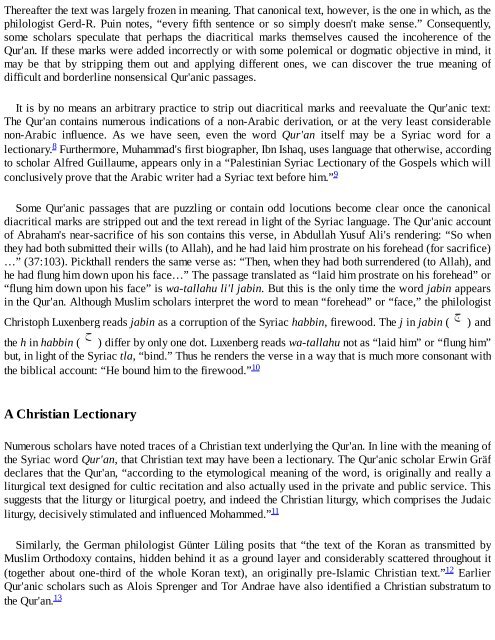robert spencer-did muhammad exist__ an inquiry into islams obscure origins-intercollegiate studies institute (2012) (1)
You also want an ePaper? Increase the reach of your titles
YUMPU automatically turns print PDFs into web optimized ePapers that Google loves.
Thereafter the text was largely frozen in me<strong>an</strong>ing. That c<strong>an</strong>onical text, however, is the one in which, as the<br />
philologist Gerd-R. Puin notes, “every fifth sentence or so simply doesn't make sense.” Consequently,<br />
some scholars speculate that perhaps the diacritical marks themselves caused the incoherence of the<br />
Qur'<strong>an</strong>. If these marks were added incorrectly or with some polemical or dogmatic objective in mind, it<br />
may be that by stripping them out <strong>an</strong>d applying different ones, we c<strong>an</strong> discover the true me<strong>an</strong>ing of<br />
difficult <strong>an</strong>d borderline nonsensical Qur'<strong>an</strong>ic passages.<br />
It is by no me<strong>an</strong>s <strong>an</strong> arbitrary practice to strip out diacritical marks <strong>an</strong>d reevaluate the Qur'<strong>an</strong>ic text:<br />
The Qur'<strong>an</strong> contains numerous indications of a non-Arabic derivation, or at the very least considerable<br />
non-Arabic influence. As we have seen, even the word Qur'<strong>an</strong> itself may be a Syriac word for a<br />
lectionary. 8 Furthermore, Muhammad's first biographer, Ibn Ishaq, uses l<strong>an</strong>guage that otherwise, according<br />
to scholar Alfred Guillaume, appears only in a “Palestini<strong>an</strong> Syriac Lectionary of the Gospels which will<br />
conclusively prove that the Arabic writer had a Syriac text before him.” 9<br />
Some Qur'<strong>an</strong>ic passages that are puzzling or contain odd locutions become clear once the c<strong>an</strong>onical<br />
diacritical marks are stripped out <strong>an</strong>d the text reread in light of the Syriac l<strong>an</strong>guage. The Qur'<strong>an</strong>ic account<br />
of Abraham's near-sacrifice of his son contains this verse, in Abdullah Yusuf Ali's rendering: “So when<br />
they had both submitted their wills (to Allah), <strong>an</strong>d he had laid him prostrate on his forehead (for sacrifice)<br />
…” (37:103). Pickthall renders the same verse as: “Then, when they had both surrendered (to Allah), <strong>an</strong>d<br />
he had flung him down upon his face…” The passage tr<strong>an</strong>slated as “laid him prostrate on his forehead” or<br />
“flung him down upon his face” is wa-tallahu li'l jabin. But this is the only time the word jabin appears<br />
in the Qur'<strong>an</strong>. Although Muslim scholars interpret the word to me<strong>an</strong> “forehead” or “face,” the philologist<br />
Christoph Luxenberg reads jabin as a corruption of the Syriac habbin, firewood. The j in jabin (<br />
the h in habbin ( ) differ by only one dot. Luxenberg reads wa-tallahu not as “laid him” or “flung him”<br />
but, in light of the Syriac tla, “bind.” Thus he renders the verse in a way that is much more conson<strong>an</strong>t with<br />
the biblical account: “He bound him to the firewood.” 10<br />
) <strong>an</strong>d<br />
A Christi<strong>an</strong> Lectionary<br />
Numerous scholars have noted traces of a Christi<strong>an</strong> text underlying the Qur'<strong>an</strong>. In line with the me<strong>an</strong>ing of<br />
the Syriac word Qur'<strong>an</strong>, that Christi<strong>an</strong> text may have been a lectionary. The Qur'<strong>an</strong>ic scholar Erwin Gräf<br />
declares that the Qur'<strong>an</strong>, “according to the etymological me<strong>an</strong>ing of the word, is originally <strong>an</strong>d really a<br />
liturgical text designed for cultic recitation <strong>an</strong>d also actually used in the private <strong>an</strong>d public service. This<br />
suggests that the liturgy or liturgical poetry, <strong>an</strong>d indeed the Christi<strong>an</strong> liturgy, which comprises the Judaic<br />
liturgy, decisively stimulated <strong>an</strong>d influenced Mohammed.” 11<br />
Similarly, the Germ<strong>an</strong> philologist Günter Lüling posits that “the text of the Kor<strong>an</strong> as tr<strong>an</strong>smitted by<br />
Muslim Orthodoxy contains, hidden behind it as a ground layer <strong>an</strong>d considerably scattered throughout it<br />
(together about one-third of the whole Kor<strong>an</strong> text), <strong>an</strong> originally pre-Islamic Christi<strong>an</strong> text.” 12 Earlier<br />
Qur'<strong>an</strong>ic scholars such as Alois Sprenger <strong>an</strong>d Tor Andrae have also identified a Christi<strong>an</strong> substratum to<br />
the Qur'<strong>an</strong>. 13


